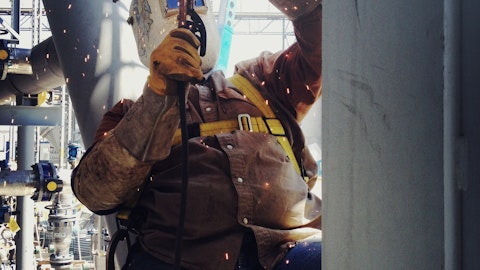David Schulz: Very confident. We are — first of all, the way that you frame that from the math is absolutely correct. When you take a look at the first half results from an organic sales relative to what we provided for our full year outlook, we do have the expectation, as we mentioned earlier, that we will see EPS growth in the back half of the year. We would still expect that we would see a continued performance from both our CSS business and our UBS business. Again, they’ve had very strong first half of the year. So from that perspective, we also indicate that July was a two-speed month. We saw things very, very slow the first couple of weeks. The second half of the month did pick up dramatically across all of our businesses. Again, from our perspective, we’ve incorporated the July results, along with our outlook for the performance by operating group to inform our outlook for the second half.
Nigel Coe: Okay. Thanks, Dave. Thanks, John.
Operator: Thank you. And our next question today comes from Christopher Glynn with Oppenheimer. Please go ahead.
Christopher Glynn: Thanks. Good morning, guys. I had a question on free cash flow. A lot of times a little lower sales outlook enables a higher free cash flow in the distribution model and particularly with the past couple of years, investment in inventory growth. So curious what the rub is there.
David Schulz: Yes, Chris, it’s Dave Schulz. So one of the things that we indicated was we do expect our fourth quarter to be sequentially stronger than the third quarter. So a lot of this will be the timing of the sales that we have in our outlook by quarter. And given the stronger sales that we would expect in the fourth quarter that would lead to a higher receivables balance. So that is a drag on our typical model where we would see seasonal declines in the fourth quarter, therefore releasing more net working capital. We’ve built into our outlook that we don’t expect that to happen this year at the same level.
Christopher Glynn: Okay. So would you expect that set up for a particularly strong free cash flow next year, again, given the backdrop of a couple of years of pretty pronounced working capital growth?
David Schulz: That is correct. Typically, we see our first quarter sales down sequentially versus the fourth quarter. Depending on the timing of projects, we would expect to release that accounts receivable build in the fourth quarter.
Christopher Glynn: Okay. Thank you.
Operator: Thank you. And our next question today comes from Steve Volkmann with Jefferies. Please go ahead.
Stephen Volkmann: Great. Good morning, guys. Just a couple of kind of follow-ups here. Dave, how are you thinking about opportunities to pay down some of the sort of higher coupon debt? I know it’s not due for a year or two. But are there ways to do that in the shorter term?
David Schulz: Yes, Steve. We’re always looking at what are the opportunities for us to refinance. We do have a $1.5 billion note that is maturing in 2025. And we’ve talked about this previously that now that the break fees for calling that bond or further reduced, we’re always looking at that. It’s really the difference between the break fees versus the interest rate arbitrage. So that is something that we’re looking at consistently.
Stephen Volkmann: Okay. Great. And then I’m curious how we should think about — you’ve been talking about some of these project wins and mega projects that certainly — I think we all see that opportunity. But how do we think about the margin mix as those start to come in? Maybe are they a little lower gross margin, but also lower SG&A? I’m just trying to think about how that plays out over the next couple of years.
John Engel: That’s a great, great question. So, yes, if the project — there’ll be portions of fulfilling the project demand, Steve, that will fill out of our stock and flow. But then there’ll be other — the engineered components, the engineered solutions that are part of that total solution, in some cases, not all, but in some cases, gets directly shipped from our supplier partner to the customer’s job site where that construction is occurring or the build is occurring. So when the fulfillment method for that particular category is what we’ll call direct ship, there’s a portion of that project, we run, it’s lower gross margins, inherently lower gross margins. But the operating cost to run that business model is also inherently lower.
So we’re relatively agnostic at the EBITDA margin line. So just I wanted to make that point. Second point I’ll make, which is very important is — and we didn’t get this question at, but we typically get it, what’s the backlog of what is — what’s the margin of what’s sitting in backlog, what’s the trend on that. And the trend on that remains strong. They’re holding up. Up slightly. So call it very stable, actually up slightly. So that’s a very good indicator of our value-based pricing, the margin improvement program as we’re winning these bigger projects that have increased scope. Some are longer in duration. We’re selling the value proposition just beyond the products that are prior to product solution. If they’re services, hence the ability to execute that project consistent with all the customers’ commitments, that we’re doing a better job increasingly of getting paid for.





